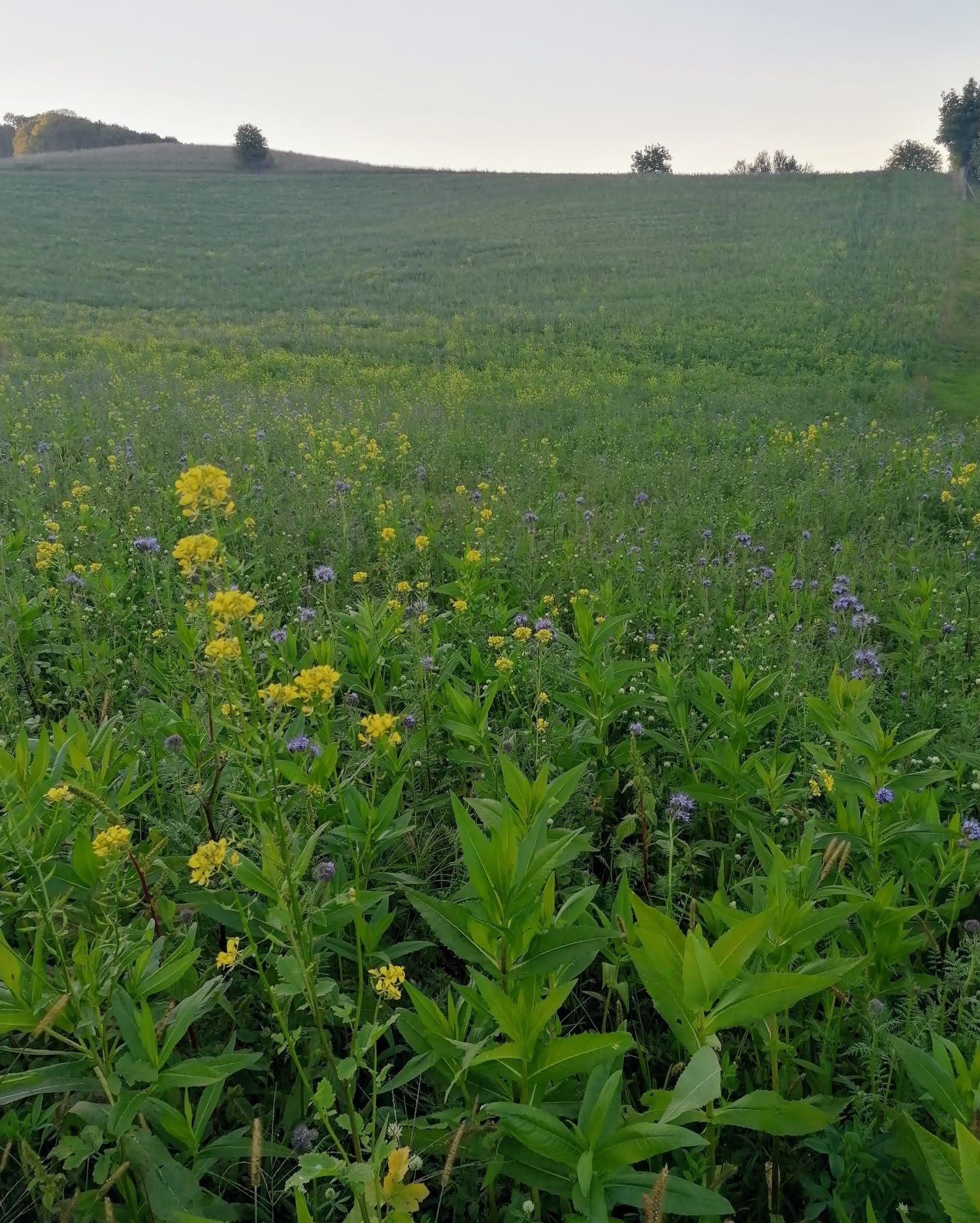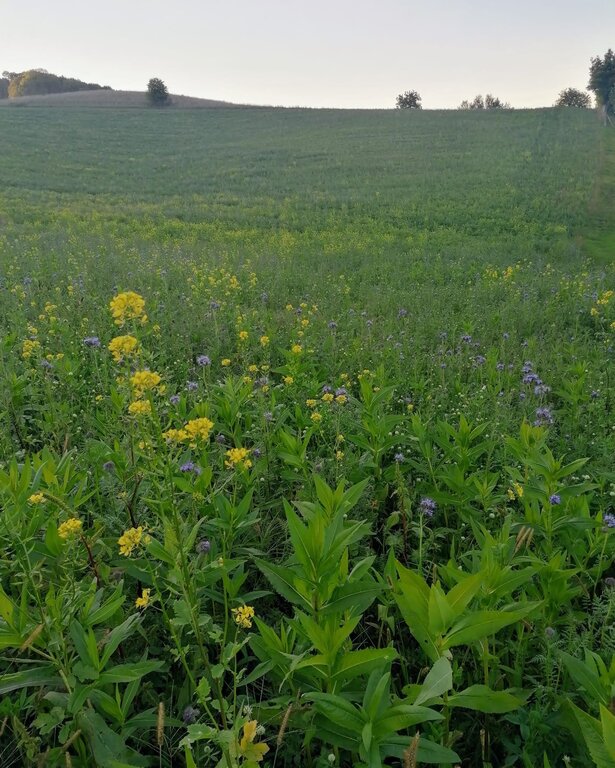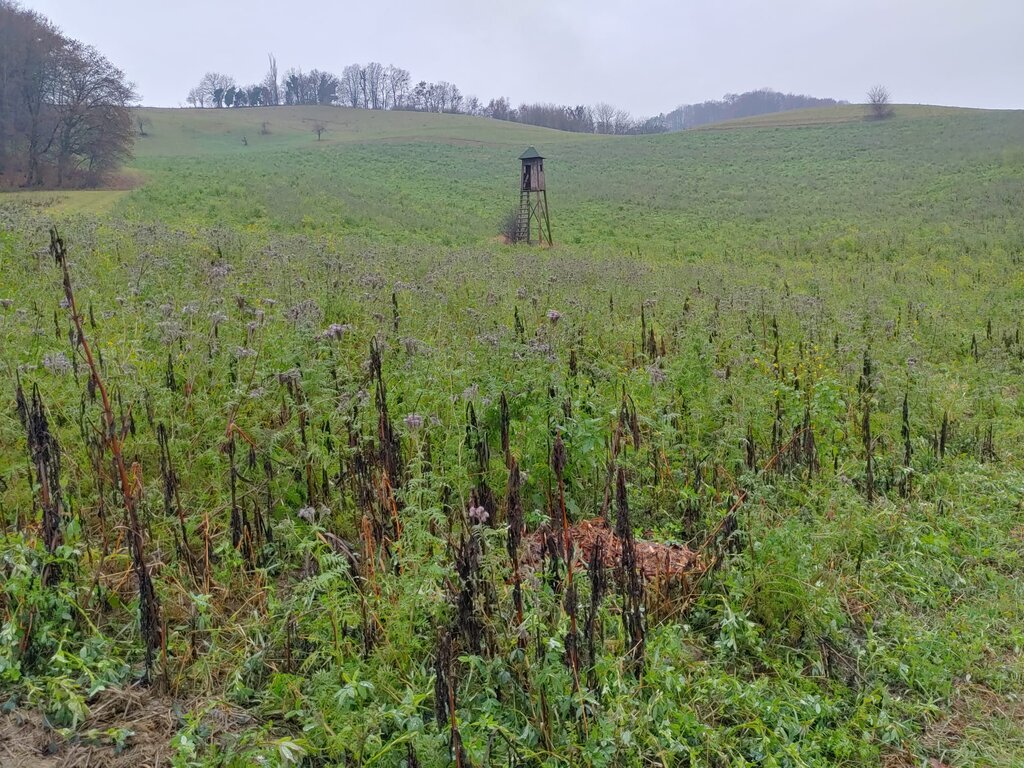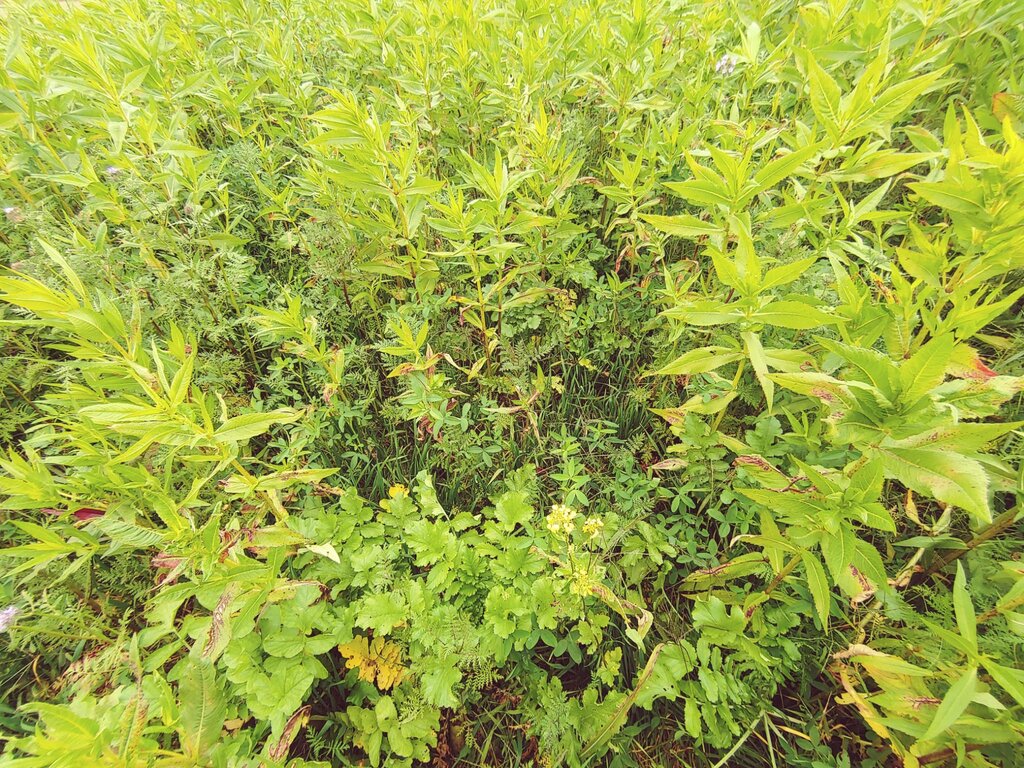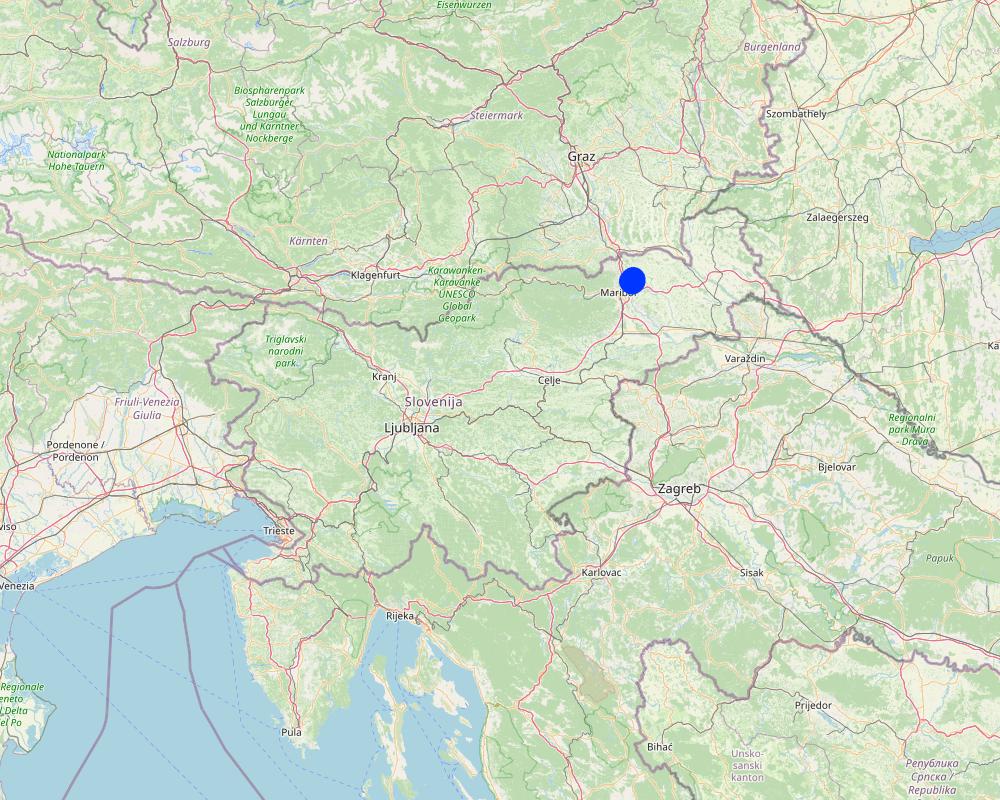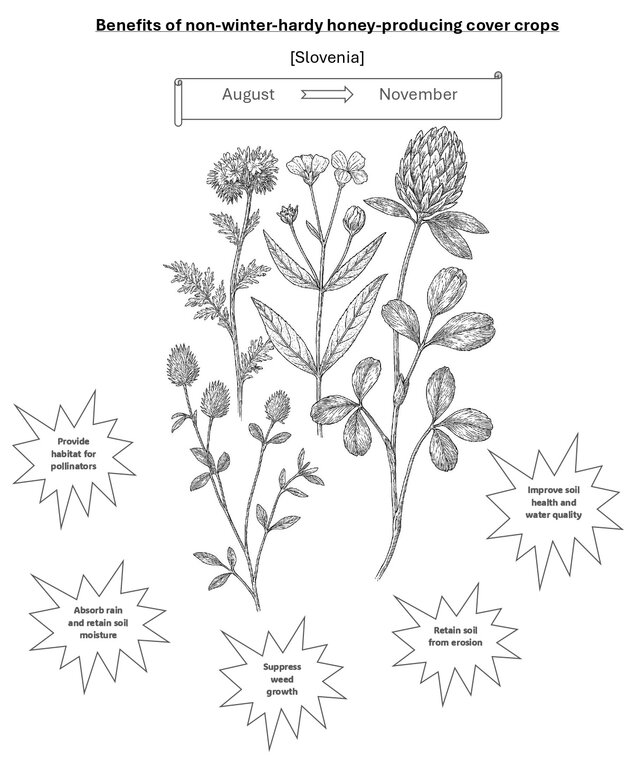Non-winter-hardy honey-producing cover crops [ប្រទេសស្លូវេនី]
- ការបង្កើត៖
- បច្ចុប្បន្នភាព
- អ្នកចងក្រង៖ Gregor Kramberger
- អ្នកកែសម្រួល៖ Tamara Korošec
- អ្នកត្រួតពិនិត្យច្រើនទៀត៖ William Critchley, Rima Mekdaschi Studer
Neprezimni medonosni posevki
technologies_7463 - ប្រទេសស្លូវេនី
ពិនិត្យមើលគ្រប់ផ្នែក
ពង្រីកមើលទាំងអស់ បង្រួមទាំងអស់1. ព័ត៌មានទូទៅ
1.2 ព័ត៌មានលម្អិតពីបុគ្គលសំខាន់ៗ និងស្ថាប័នដែលចូលរួមក្នុងការវាយតម្លៃ និងចងក្រងឯកសារនៃបច្ចេកទេស
អ្នកជំនាញឯកទេស SLM:
អ្នកប្រើប្រាស់ដី:
Ropič Andrej
Farmer
ប្រទេសស្លូវេនី
co-compiler:
Horvat Tomotej
Chamber of Agriculture and Forestry of Slovenia (KGZS) – Institute of Agriculture and Forestry Maribor
ប្រទេសស្លូវេនី
ឈ្មោះគម្រោងដែលបានចងក្រងឯកសារ/ វាយតម្លៃលើបច្ចេកទេស (បើទាក់ទង)
OPtimal strategies to retAIN and re-use water and nutrients in small agricultural catchments across different soil-climatic regions in Europe (OPTAIN)ឈ្មោះអង្គភាពមួយ (ច្រើន) ដែលបានចងក្រងឯកសារ/ វាយតម្លៃបច្ចេកទេស (បើទាក់ទង)
Chamber of Agriculture and Forestry of Slovenia – Institute of Agriculture and Forestry Maribor (KGZS) - ប្រទេសស្លូវេនី1.3 លក្ខខណ្ឌទាក់ទងទៅនឹងការប្រើប្រាស់ទិន្នន័យដែលបានចងក្រងតាមរយៈ វ៉ូខេត
អ្នកចងក្រង និង(បុគ្គលសំខាន់ៗ)យល់ព្រមទទួលយកនូវលក្ខខណ្ឌនានាទាក់ទងទៅនឹងការប្រើប្រាស់ទិន្នន័យដែលបានចងក្រងតាមរយៈវ៉ូខេត:
បាទ/ចា៎
1.4 សេចក្តីប្រកាសស្តីពីចីរភាពនៃការពណ៌នាពីបច្ចេកទេស
តើបច្ចេកទេសដែលបានពណ៌នានេះមានបញ្ហាដែលផ្តោតលើការធ្លាក់ចុះគុណភាពដី, បើដូច្នេះវាមិនអាចត្រូវបានប្រកាសថាជាបច្ចេកទេសនៃការគ្រប់គ្រងប្រកបដោយចីរភាពទេ?
ទេ
2. ការពណ៌នាពីបច្ចេកទេស SLM
2.1 ការពណ៌នាដោយសង្ខេបពីបច្ចេកទេស
និយមន័យបច្ចេកទេស:
Non-winter-hardy honey-producing cover crops enhance soil fertility, prevent erosion, reduce nutrient leaching, and support biodiversity. These fast-growing, flowering plants are integrated into crop rotation, offering ecological and long-term economic benefits - and are supported by EU agricultural subsidies.
2.2 ការពណ៌នាលម្អិតពីបច្ចេកទេស
ការពណ៌នា:
Cover cropping with non-winter-hardy honey-producing mixtures is expanding on arable land in Slovenia, especially in lowland areas near water protection zones, streams, and other water bodies. These plants are often integrated into crop rotations of both conventional and organic farming systems. Together with winter-hardy cover crops, these mixtures are an essential component of good sustainable land management. Supported by the EU's Common Agricultural Policy through SOPO (Schemes for Climate and Environment) and KOPOP (Agri-Environmental-Climate Payments), this technology promotes sustainable agriculture by improving soil structure and health and preventing nutrient leaching.
Cover crops - also referred to as catch crops or green manures - are fast-growing, plants from various families, mostly legumes, grasses and brassicas. After the main crop harvest, these plants are sown and cover the soil during summer, autumn, and winter. We distinguish between winter-hardy and non-winter-hardy cover crops.
One of the most popular non-winter-hardy mixtures used in Slovenia, includes Egyptian clover (Trifolium alexandrinum), red clover (Trifolium pratense), phacelia (Phacelia tanacetifolia), and niger (Guizotia abyssinica). These species are drought-tolerant, support pollinators, and naturally perish after the first frost, simplifying subsequent soil preparation.
Their main functions are to improve soil fertility, retain moisture, prevent erosion, and reduce nutrient leaching into waterways. The different characteristics of the species in the mixture combine multiple advantages:
- dissimilar root systems extract nutrients from different layers of the soil;
- the various plant species extract different root exudates, which serve as a nutrient source for soil microorganisms;
- compacted soils become loose and of better structure;
- these species combined lead to enriched organic matter and humus;
- flowering species provide forage for pollinators;
- an overall impact is a reduced need for fertilizers and pesticides which in turn enhances water quality and lowers environmental risks;
- the leguminous species in the mixture fix nitrogen from the air, and follow-up crops like maize require less fertilizer, reducing greenhouse gas emissions.
Honey-producing non-winter-hardy mixtures are typically included in multi-year crop rotation plans. Activities involve selecting appropriate plant species/varieties or mixtures or species/varieties based on soil, climate, rotation and function requirements.
Shallow cultivation or direct sowing on well-prepared seedbeds takes place after cereal harvest, generally in July and August, with a recommended seeding rate of 12 kg/ha. Farmers usually avoid additional fertilization, as soil nutrients suffice for the growth of cover crops. Minimal maintenance is needed during growth since these plants suppress weeds and reduce pest pressure. Termination involves natural frost die-off, mulching, rolling, or shallow tillage. Detailed record-keeping ensures compliance with subsidy programs and supports long-term benefits.
Farmers value such cover cropping for its multiple benefits. They very much appreciate the subsidies they get for their additional effort to sow cover crops. However, challenges include higher initial costs, dependency on appropriate weather, complex timing of operations, and potential competition with main crops. Despite these hurdles, many farmers see cover cropping as a critical component of sustainable farming practices.
2.3 រូបភាពនៃបច្ចេកទេស
2.5 ប្រទេស/តំបន់/ទីតាំងកន្លែង ដែលបច្ចេកទេសត្រូវបានអនុវត្ត និងបានគ្រប់ដណ្តប់ដោយការវាយតម្លៃនេះ
ប្រទេស:
ប្រទេសស្លូវេនី
តំបន់/រដ្ឋ/ខេត្ត:
Jareninski dol, Pernica
បញ្ជាក់បន្ថែមពីលក្ខណៈនៃទីតាំង:
Vosek
បញ្ជាក់ពីការសាយភាយនៃបច្ចេកទេស:
- ត្រូវបានផ្សព្វផ្សាយត្រឹមតំបន់មួយ
ប្រសិនបើបច្ចេកទេសត្រូវបានសាយភាយពាសពេញតំបន់ណាមួយ បញ្ជាក់ទំហំផ្ទៃដីអនុវត្តន៍ (គិតជា គ.ម2):
137,0
តើបច្ចេកទេស (មួយ ឬច្រើន) ទាំងនោះស្ថិតនៅក្នុងតំបន់ការពារជាអចិន្ត្រៃយ៍ណាមួយដែរឬទេ?
ទេ
Map
×2.6 កាលបរិច្ឆេទនៃការអនុវត្ត
បង្ហាញឆ្នាំនៃការចុះអនុវត្ត:
2020
ប្រសិនបើមិនច្បាស់ឆ្នាំ សូមបញ្ជាក់កាលបរិច្ឆេទដែលប្រហាក់ប្រហែល:
- តិចជាង 10ឆ្នាំមុន (ថ្មី)
2.7 ការណែនាំពីបច្ចេកទេស
សូមបញ្ជាក់តើបច្ចេកទេសត្រូវបានណែនាំឱ្យអនុវត្តដោយរបៀបណា:
- តាមរយៈការបង្កើតថ្មីរបស់អ្នកប្រើប្រាស់ដី
- ពេលកំពុងពិសោធន៍
មតិយោបល់ (ប្រភេទនៃគម្រោង ។ល។):
The farmer adopted cover cropping as part of his transition to low-tillage farming, supported by experimentation and guidance from the public advisory service. The measure, backed by CAP subsidies, was adopted after research and experimentation, ensuring its effective integration into his farming system.
3. ចំណាត់ថ្នាក់នៃបច្ចេកទេស SLM
3.1 គោលបំណងចម្បង (១ ឬច្រើន) នៃបច្ចេកទេសនេះ
- ធ្វើឱ្យប្រសើរឡើងនូវផលិតកម្ម
- កាត់បន្ថយ, បង្ការ, ស្តារឡើងវិញនូវការធ្លាក់ចុះគុណភាពដី
- អភិរក្សប្រព័ន្ធអេកូឡូស៊ី
- ការពារតំបន់ទីជម្រាល/តំបន់ខ្សែទឹកខាងក្រោមបញ្ចូលជាមួយបច្ចេកទេសផ្សេងទៀត
- អភិរក្ស/ធ្វើឱ្យប្រសើរឡើងជីវចម្រុះ
3.2 ប្រភេទដីប្រើប្រាស់មួយប្រភេទ (ច្រើនប្រភេទ) ដែលបានអនុវត្តបច្ចេកទេស
ដីប្រើប្រាស់ចម្រុះនៅលើដីតែមួយ:
ទេ
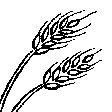
ដីដាំដំណាំ
- ដំណាំប្រចាំឆ្នាំ
ដំណាំប្រចាំឆ្នាំ - បញ្ជាក់ប្រភេទដំណាំ:
- ធញ្ញជាតិ - ស្រូវ
- ធញ្ញជាតិ - ពោត
- ធញ្ញជាតិ - ស្រូវសាលី (សិសិររដូវរងារ)
ចំនួនសារដែលដាំដំណាំក្នុងមួយឆ្នាំ:
- 1
តើជាការអនុវត្តន៍ដំណាំចន្លោះ?
បាទ/ចា៎
ប្រសិនបើបាទ/ច៎ា សូមបញ្ជាក់ប្រភេទដំណាំដែលដាំចន្លោះគ្នានោះ:
The first year of the rotation comprises a mix of grasses and legumes
តើជាការអនុវត្តន៍ដំណាំវិលជុំ?
បាទ/ចា៎
បើបាទ/ច៎ា សូមបញ្ជាក់:
The farmer practices a 4- to 5-year crop rotation plan, primarily involving maize and winter cereals. After the harvest of winter cereals (e.g., wheat) in July, cover crops are sown in early August to protect the soil, enhance fertility, and support low-tillage practices.
3.3 បន្ទាប់ពីអនុវត្តបច្ចេកទេស តើដីប្រើប្រាស់មានការប្រែប្រួលដែររឺទេ?
បន្ទាប់ពីអនុវត្តបច្ចេកទេស តើដីប្រើប្រាស់មានការប្រែប្រួលដែររឺទេ?
- ទេ (បន្តទៅសំណួរ 3.4)
3.4 ការផ្គត់ផ្គង់ទឹក
ការផ្គត់ផ្គង់ទឹកនៅកន្លែងអនុវត្តបច្ចេកទេស:
- ទឹកភ្លៀង
3.5 ក្រុម SLM ដែលបច្ចេកទេសស្ថិតនៅក្នុង
- ធ្វើឱ្យប្រសើរឡើងគម្របដី/ ដំណាំគម្របដី
- កាត់បន្ថយការរំខានដល់ដី
- ការគ្រប់គ្រងជីជាតិដីតាមបែបចម្រុះ
3.6 វិធានការ SLM ដែលបញ្ចូលនូវបច្ចេកទេស
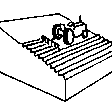
វិធានការក្សេត្រសាស្ត្រ
- A1: ដំណាំ/គម្របដី
- A2: សារធាតុសរីរាង្គ/ជីជាតិដី
- A6: ការគ្រប់គ្រងកាកសំណល់
A6: បញ្ជាក់ពីការគ្រប់គ្រងកាកសំណល់:
A 6.4: រក្សាទុក
3.7 កំណត់ប្រភេទនៃការធ្លាក់ចុះគុណភាពដីសំខាន់ៗដែលបច្ចេកទេសនេះបានដោះស្រាយ
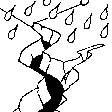
ការហូរច្រោះដីដោយសារទឹក
- Wt: ការបាត់ដីស្រទាប់លើដោយការហូរច្រោះ
- Wg: ការកកើតឡើងនូវកំទេចកំទីដីស្រទាប់ក្រោម
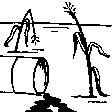
ការធ្លាក់ចុះសារធាតុគីមីក្នុងដី
- Cn: ការថយចុះជីជាតិ និងកាត់បន្ថយបរិមាណសារធាតុសរីរាង្គ (មិនកើតឡើងដោយការហូរច្រោះទេ)
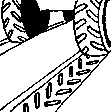
ការបាត់បង់រូបសាស្ត្រនៃដី
- Pc: ការហាប់ណែន
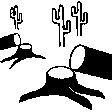
ការធ្លាក់ចុះជីវសាស្ត្រនៃដី
- Bc: ការថយចុះនូវគម្របរុក្ខជាតិ
- Bq: ការថយចុះនូវជីវម៉ាស/ បរិមាណ
- Bl: ការបាត់បង់មីក្រូ និងម៉ាក្រូសរីរាង្គរបស់ដី
- Bp: ការកើនឡើងនូវសត្វល្អិត ឬជំងឺ បាត់បង់នូវសត្វមានប្រយោជន៍
3.8 ការពារ កាត់បន្ថយ ឬស្តារឡើងវិញនៃការធ្លាក់ចុះគុណភាពដី
បញ្ជាក់ពីគោលដៅរបស់បច្ចេកទេស ដែលផ្តោតទៅការធ្លាក់ចុះគុណភាពដី:
- ការការពារការធ្លាក់ចុះគុណភាពដី
- ការកាត់បន្ថយការធ្លាក់ចុះគុណភាពដី
4. បច្ចេកទេសជាក់លាក់ សកម្មភាពអនុវត្ត ធាតុចូល និងថ្លៃដើម
4.1 គំនូសបច្ចេកទេសនៃបច្ចេកទេសនេះ
លក្ខណៈពិសេសនៃបច្ចេកទេស (ទាក់ទងនឺងគំនូរបច្ចេកទេស):
Technical specifications for sowing non-winter-hardy honey-producing mixture
Sowing time: Sowing is recommended immediately after the harvest of winter cereals, in late July or early August.
Seeding rate: 12 kg/ha
Soil preparation: High-quality seedbed preparation is necessary due to the small seed size. Blind sowing is recommended to destroy or prevent the growth of weeds.
Sowing depth: Seeds are sown shallowly, typically at a depth of 1–2 cm, depending on soil conditions.
Row spacing: Cover crops are typically sown using a grain drill with a row spacing of 12.5 cm (approximately 5 inches) or broadcasted using a fertilizer spreader. Drilling ensures precise seed placement and consistent depth, promoting uniform germination. Broadcasting, on the other hand, involves spreading seeds evenly across the soil surface, often followed by light incorporation to enhance seed-to-soil contact. Both methods are widely used, with the choice depending on specific field conditions and equipment. Plant height: Plants in the mixture grow to a height of 50–100 cm, depending on the varieties used and growing conditions.
Winter hardiness: The plants in the mixture are non-winter-hardy; they perish with the first autumn frost, simplifying autumn or spring plowing.
Suitability for crop rotation: The mixture integrates well into crop rotation as species in it are not related to cash crops. It is sown after the harvest of winter cereals and other early/spring cash crops.
This mixture is particularly suitable for water protection areas as its intense growth prevents the leaching of excess nitrogen from the soil into groundwater, improves the water-holding capacity of the soil and effectively suppresses erosion and weeds. Additionally, its colorful flowers during the summer months enliven the landscape and provide a rich source of nectar for bees and other pollinators.
ឈ្មោះអ្នកនិពន្ធ:
Gregor Kramberger
កាលបរិច្ឆេទ:
21/07/2025
4.2 ព័ត៌មានទូទៅដែលពាក់ព័ន្ធនឹងការគណនាធាតុចូល និងថ្លៃដើម
កំណត់របៀបនៃការគណនាថ្លៃដើម និងធាតុចូល:
- ក្នុងតំបន់អនុវត្តបច្ចេកទេស
កំណត់ទំហំ និងឯកត្តាផ្ទៃដី:
11.44 ha
បើសិនប្រើឯកតាតាមតំបន់ សូមបញ្ជាក់តម្លៃបម្លែងវាទៅជាហិកតា (ឧ. 1 ហិកតា = 2.47 អា)៖ 1 ហិកតា =:
ha = 10.000 m2
ផ្សេងៗ/ រូបិយប័ណ្ណជាតិ (បញ្ជាក់):
EUR
បើពាក់ព័ន្ធសូមកំណត់អត្រាប្តូរប្រាក់ពីដុល្លាទៅរូបិយប័ណ្ណតំបន់ (ឧ. 1 ដុល្លារ = 79.9 រៀលនៃរូបិយប័ណ្ណប្រេស៊ីល) ៖ 1 ដុល្លារ =:
0,85
កំណត់ថ្លៃឈ្នួលជាមធ្យមនៃការជួលកម្លាំងពលកម្មក្នុងមួយថ្ងៃ:
114
4.3 សកម្មភាពបង្កើត
| សកម្មភាព | រយៈពេល (រដូវកាល) | |
|---|---|---|
| 1. | Purchase of a disc harrow with cover crops seed drill | 1st year |
មតិយោបល់:
The use of a disc harrow with a cover crop seed drill can support soil preparation and sowing, but it is not strictly necessary. Many farmers use other types of harrows and seeders, which may be more cost-effective or already available on the farm. In some cases, such equipment is shared or acquired through collective investment. While the typical depreciation period for this type of machinery is around 12 years, it is often used for 20 to 30 years, or as long as it remains functional and economically viable.
4.4 ថ្លៃដើម និងធាតុចូលដែលត្រូវការសម្រាប់ការបង្កើតបច្ចេកទេស
| បញ្ជាក់ពីធាតុចូល | ឯកតា | បរិមាណ | ថ្លៃដើមក្នុងមួយឯកតា | ថ្លៃធាតុចូលសរុប | % នៃថ្លៃដើមដែលចំណាយដោយអ្នកប្រើប្រាស់ដី | |
|---|---|---|---|---|---|---|
| សម្ភារៈ | Disc harrow with cover crops seed drill | piece | 1,0 | 20000,0 | 20000,0 | 70,0 |
| ថ្លៃដើមសរុបក្នុងការបង្កើតបច្ចេកទេស | 20000,0 | |||||
| ថ្លៃដើមសរុបក្នុងការបង្កើតបច្ចេកទេសគិតជាដុល្លារ | 23529,41 | |||||
ប្រសិនបើអ្នកប្រើប្រាស់ដីមិនមានថ្លៃដើម 100% សូមបញ្ជាក់ថានរណាដែលចំណាយថ្លៃដើមដែលនៅសល់:
Part of the agricultural machinery intended for the implementation of environmental measures can be funded through non-repayable grants from European and national funds under the CAP.
មតិយោបល់:
The cost of such machinery is a key factor, as equipment like a disc harrow with a seed drill can be expensive. However, it should last for 20 years (or more). Furthermore, it is not strictly necessary, many farmers use simpler or existing machinery, and shared or collective investment is also common.
4.5 សកម្មភាពថែទាំ
| សកម្មភាព | ពេលវេលា/ ភាពញឹកញាប់ | |
|---|---|---|
| 1. | Variable costs of honey-producing non-winter-hardy cover crops | Every year. |
មតិយោបល់:
Variable costs represent the total production expenses for sowing the mixture, including seeds, machinery and labor costs and financing.
4.6 កំណត់ថ្លៃដើមសម្រាប់ការថែទាំ/ សកម្មភាពរបស់បច្ចេកទេស (ក្នុងរយៈពេលមួយឆ្នាំ)
| បញ្ជាក់ពីធាតុចូល | ឯកតា | បរិមាណ | ថ្លៃដើមក្នុងមួយឯកតា | ថ្លៃធាតុចូលសរុប | % នៃថ្លៃដើមដែលចំណាយដោយអ្នកប្រើប្រាស់ដី | |
|---|---|---|---|---|---|---|
| កម្លាំងពលកម្ម | Work with machines | hour | 52,0 | 9,0 | 468,0 | 100,0 |
| សម្ភារៈ | Seedbed preparation and sowing | hour | 23,0 | 35,2 | 809,6 | 100,0 |
| សម្ភារៈ | Mulching | hour | 29,0 | 32,0 | 928,0 | 100,0 |
| សម្ភារៈដាំដុះ | Seed | ha | 11,44 | 79,2 | 906,05 | 100,0 |
| ផ្សេងៗ | Financing cost | % | 0,03 | 3089,94 | 92,7 | 100,0 |
| ថ្លៃដើមសរុបសម្រាប់ការថែទាំដំណាំតាមបច្ចេកទេស | 3204,35 | |||||
| ថ្លៃដើមសរុបសម្រាប់ការថែទាំដំណាំតាមបច្ចេកទេសគិតជាដុល្លារ | 3769,82 | |||||
មតិយោបល់:
The farmer cultivates a total of 28.6 hectares of arable land. The area is theoretically divided into five equal parts, as it follows a 5-year crop rotation system. Additionally, a cover crop is sown after barley and wheat. Therefore, we have accounted for costs on 2/5 of the additional total area.
4.7 កត្តាសំខាន់បំផុតដែលមានឥទ្ធិពលដល់ការចំណាយ
ពណ៌នាពីកត្តាប៉ះពាល់ចម្បងៗទៅលើថ្លៃដើម:
The total area is theoretically divided into five equal parts, following the 5-year crop rotation system. However, in practice, this division is not perfectly even. Other important cost factors include variations in input prices (such as seeds, fertilizers, and plant protection products), machinery costs, labor availability, and weather conditions that impact yields and operational efficiency.
5. លក្ខណៈបរិស្ថានធម្មជាតិ និងមនុស្ស
5.1 អាកាសធាតុ
បរិមាណទឹកភ្លៀងប្រចាំឆ្នាំ
- < 250 មម
- 251-500 មម
- 501-750 មម
- 751-1,000 មម
- 1,001-1,500 មម
- 1,501-2,000 មម
- 2,001-3,000 មម
- 3,001-4,000 មម
- > 4,000 មម
កំណត់បរិមាណទឹកភ្លៀង (បើដឹង) ជា មីលីម៉ែត្រ:
1032,00
លក្ខណៈពិសេស/ មតិយោបល់លើរដូវភ្លៀង:
Most precipitation falls in summer, the months with the highest average precipitation are August and September, the least precipitation falls in winter, in January and February at least, and in principle more precipitation falls in autumn than in spring.
បញ្ជាក់ឈ្មោះឯកសារយោងនៃស្ថានីយឧតុនិយម:
Jareninski Vrh (1991-2020)
តំបន់កសិអាកាសធាតុ
- មានភ្លៀងមធ្យម
The average annual air temperature at Jareninski Vrh during the reference period 1991–2020 was 10.1 °C.
5.2 សណ្ឋានដី
ជម្រាលជាមធ្យម:
- រាបស្មើ (0-2%)
- ជម្រាលតិចតួច (3-5%)
- មធ្យម (6-10%)
- ជម្រាលខ្ពស់បន្តិច (11-15%)
- ទីទួល (16-30%)
- ទីទួលចោត (31-60%)
- ទីទួលចោតខ្លាំង (>60%)
ទម្រង់ដី:
- ខ្ពង់រាប
- កំពូលភ្នំ
- ជម្រាលភ្នំ
- ជម្រាលទួល
- ជម្រាលជើងភ្នំ
- បាតជ្រលងភ្នំ
តំបន់តាមរយៈកម្ពស់ :
- 0-100 ម
- 101-500 ម
- 501-1,000 ម
- 1,001-1,500 ម
- 1,501-2,000 ម
- 2,001-2,500 ម
- 2,501-3,000 ម
- 3,001-4,000 ម
- > 4,000 ម
បញ្ជាក់ថាតើបច្ចេកទេសនេះត្រូវបានអនុវត្តន៍នៅក្នុង:
- មិនពាក់ព័ន្ធទាំងអស់
5.3 ដី
ជម្រៅដីជាមធ្យម:
- រាក់ខ្លាំង (0-20 សម)
- រាក់ (21-50 សម)
- មធ្យម (51-80 សម)
- ជ្រៅ (81-120 សម)
- ជ្រៅខ្លាំង (> 120 សម)
វាយនភាពដី (ស្រទាប់លើ):
- មធ្យម (ល្បាយ, ល្បាប់)
វាយនភាពដី (> 20 សម ស្រទាប់ក្នុង):
- មធ្យម (ល្បាយ, ល្បាប់)
សារធាតុសរីរាង្គនៅស្រទាប់ដីខាងលើ:
- មធ្យម (1-3%)
5.4 ទឹកដែលអាចទាញមកប្រើប្រាស់បាន និងគុណភាពទឹក
នីវ៉ូទឹកក្រោមដី:
5-50 ម
ទឹកលើដីដែលអាចទាញយកប្រើប្រាស់បាន:
ល្អ
គុណភាពទឹក (មិនបានធ្វើប្រត្តិកម្ម):
ទឹកសម្រាប់តែការធ្វើកសិកម្ម (ស្រោចស្រព)
គុណភាពទឹក គឺផ្តោតទៅលើ៖:
ទឹកលើផ្ទៃដី
តើមានបញ្ហាភាពទឹកប្រៃហូរចូលមកដែរឬទេ?
ទេ
តើទឹកជំនន់កំពុងកើតមាននៅតំបន់នេះដែររឺទេ?
បាទ/ចា៎
ភាពទៀងទាត់:
ម្តងម្កាល
មតិយោបល់ និងលក្ខណៈពិសេសផ្សេងៗទៀតលើគុណភាព និងបរិមាណទឹក :
Hydromelioration was carried out in the area, a drainage system and water retention systems (e.g. ponds and basins) were arranged.
5.5 ជីវៈចម្រុះ
ភាពសម្បូរបែបនៃប្រភេទ:
- កម្រិតមធ្យម
ភាពសម្បូរបែបនៃទីជម្រក:
- កម្រិតមធ្យម
5.6 លក្ខណៈនៃអ្នកប្រើប្រាស់ដីដែលអនុវត្តបច្ចេកទេស
នៅមួយកន្លែង ឬពនេចរ :
- នៅមួយកន្លែង
ទីផ្សារនៃប្រព័ន្ធផលិតកម្ម:
- ពាណិជ្ជកម្ម/ ទីផ្សារ
ចំណូលក្រៅកសិកម្ម:
- 10-50% នៃចំណូល
កម្រិតជីវភាព:
- មធ្យម
ឯកជន ឬក្រុម:
- ធ្វើខ្លួនឯង/ គ្រួសារ
កម្រិតប្រើប្រាស់គ្រឿងយន្ត:
- គ្រឿងយន្ត/ ម៉ាស៊ីន
យេនឌ័រ:
- បុរស
អាយុរបស់អ្នកប្រើប្រាស់ដី:
- វ័យកណ្តាល
5.7 ទំហំផ្ទៃដីជាមធ្យមនៃដីប្រើប្រាស់ដោយអ្នកប្រើប្រាស់ដី ក្នុងការអនុវត្តបច្ចេកទេស
- < 0.5 ហិកតា
- 0.5-1 ហិកតា
- 1-2 ហិកតា
- 2-5 ហិកតា
- 5-15 ហិកតា
- 15-50 ហិកតា
- 50-100 ហិកតា
- 100-500 ហិកតា
- 500-1,000 ហិកតា
- 1,000-10,000 ហិកតា
- > 10,000 ហិកតា
តើផ្ទៃដីនេះចាត់ទុកជាទំហំកម្រិតណាដែរ ខ្នាតតូច មធ្យម ឬខ្នាតធំ (ធៀបនឹងបរិបទតំបន់)?
- ខ្នាតមធ្យម
មតិយោបល់:
In 2023, the average agricultural holding in Slovenia manages 8.8 hectares of utilized agricultural land.
5.8 ភាពជាម្ចាស់ដី កម្មសិទ្ធប្រើប្រាស់ដី និងកម្មសិទ្ធប្រើប្រាស់ទឹក
ភាពជាម្ចាស់ដី:
- ឯកជន មានកម្មសិទ្ធ
កម្មសិទ្ធិប្រើប្រាស់ដី:
- កិច្ចសន្យាជួល
- ឯកជន
កម្មសិទ្ធប្រើប្រាស់ទឹក:
- ជាក្រុម (មានដែនកំណត់)
តើកម្មសិទ្ធប្រើប្រាស់ដី គឺផ្អែកលើប្រព័ន្ធច្បាប់បែបបុរាណ?
ទេ
សូមបញ្ជាក់:
Based on national legal system.
5.9 ការប្រើប្រាស់សេវាកម្ម និងហេដ្ឋារចនាសម្ព័ន្ធ
សុខភាព:
- មិនល្អ
- មធ្យម
- ល្អ
ការអប់រំ:
- មិនល្អ
- មធ្យម
- ល្អ
ជំនួយបច្ចេកទេស:
- មិនល្អ
- មធ្យម
- ល្អ
ការងារ (ឧ. ការងារក្រៅកសិដ្ឋាន):
- មិនល្អ
- មធ្យម
- ល្អ
ទីផ្សារ:
- មិនល្អ
- មធ្យម
- ល្អ
ថាមពល:
- មិនល្អ
- មធ្យម
- ល្អ
ផ្លូវ និងការដឹកជញ្ជូន:
- មិនល្អ
- មធ្យម
- ល្អ
ទឹកផឹក និងអនាម័យ:
- មិនល្អ
- មធ្យម
- ល្អ
សេវាកម្មហិរញ្ញវត្ថុ:
- មិនល្អ
- មធ្យម
- ល្អ
6. ផលប៉ះពាល់ និងការសន្និដ្ឋាន
6.1 ផលប៉ះពាល់ក្នុងបរិវេណអនុវត្តបច្ចេកទេសដែលកើតមាន
ផលប៉ះពាល់លើសេដ្ឋកិច្ចសង្គម
ផលិតផល
ផលិតកម្មដំណាំ
មតិយោបល់/ ការបញ្ជាក់:
Cover crops improve soil fertility, moisture retention, and nutrient availability, leading to slight yield improvements in the following crop. The impact depends on crop rotation, soil conditions, and cover crop management.
ផលិតកម្មចំណីសត្វ
មតិយោបល់/ ការបញ្ជាក់:
Cover crops used in this system are not intended for grazing or fodder production; their role is primarily soil conservation and fertility enhancement. Usually, they are incorporated into the soil.
ការគ្រប់គ្រងដី
មតិយោបល់/ ការបញ្ជាក់:
Cover crops enhance soil conservation, reduce the need for intensive tillage, and improve crop rotation efficiency.
ចំណូល និងថ្លៃដើម
ការចំណាយលើធាតុចូលកសិកម្ម
មតិយោបល់/ ការបញ្ជាក់:
Cover crops reduce the need for fertilizers and herbicides, but additional costs for seeds and labor partially offset these savings.
ចំណូលក្នុងកសិដ្ឋាន
មតិយោបល់/ ការបញ្ជាក់:
Cover crops require an initial investment, but long-term benefits such as reduced input costs and improved soil fertility may positively impact farm income over time.
បន្ទុកការងារ
មតិយោបល់/ ការបញ្ជាក់:
Additional labor required for sowing and managing cover crops.
ផលប៉ះពាល់ទៅលើអេកូឡូស៊ី
វដ្តទឹក/លំហូរ
រំហួត
មតិយោបល់/ ការបញ្ជាក់:
Cover crops reduce direct soil exposure, lowering evaporation and improving water retention.
ដី
សំណើមដី
មតិយោបល់/ ការបញ្ជាក់:
Cover crops enhance soil moisture by reducing evaporation and improving water infiltration.
គម្របដី
មតិយោបល់/ ការបញ្ជាក់:
Cover crops provide continuous ground cover, protecting the soil from erosion, nutrient loss, and extreme weather conditions.
ការបាត់បង់ដី
មតិយោបល់/ ការបញ្ជាក់:
Cover crops significantly reduce soil loss by stabilizing the soil, preventing erosion, and improving infiltration.
ជីវចម្រុះ៖ ដំណាំ, សត្វ
ដំណាំគម្រប
មតិយោបល់/ ការបញ្ជាក់:
Cover crops provide continuous plant cover, reducing bare soil exposure and enhancing biodiversity.
ជីវម៉ាស/ កាបូនលើដី
មតិយោបល់/ ការបញ្ជាក់:
Cover crops contribute significantly to above-ground biomass accumulation, increasing organic carbon input into the soil.
ភាពសម្បូរបែបនៃរុក្ខជាតិ
មតិយោបល់/ ការបញ្ជាក់:
Cover crops introduce multiple species into the cropping system, enhancing plant diversity and ecosystem resilience.
ប្រភេទសត្វមានប្រយោជន៍
មតិយោបល់/ ការបញ្ជាក់:
Cover crops support pollinators, natural pest predators, and soil organisms, enhancing ecosystem balance.
ភាពសម្បូរបែបនៃទីជំរក
មតិយោបល់/ ការបញ្ជាក់:
Cover crops create diverse habitats for pollinators, beneficial insects, and soil organisms, improving ecosystem resilience.
ការគ្រប់គ្រងកត្តាចង្រៃ/ ជំងឺ
មតិយោបល់/ ការបញ្ជាក់:
Cover crops help break pest and disease cycles, support beneficial insects, and improve soil health, reducing outbreaks.
ការកាត់បន្ថយហានិភ័យនៃគ្រោះមហន្តរាយ និងគ្រោះអាកាសធាតុ
ផលប៉ះពាល់នៃគ្រោះរាំងស្ងួត
មតិយោបល់/ ការបញ្ជាក់:
Cover crops enhance water retention, reduce evaporation, and improve soil structure, making fields more resilient to drought.
បញ្ជាក់ពីការប៉ាន់ស្មាននៃផលប៉ះពាល់ក្នុងបរិវេណអនុវត្តបច្ចេកទេស (វាស់វែង):
The data have not been obtained through specific measurements but rather through a questionnaire with the farmer and insights from other farms and agricultural advisors.
6.2 ផលប៉ះពាល់ក្រៅបរិវេណអនុវត្តបច្ចេកទេសដែលកើតមាន
Buffering/សមត្ថភាពចម្រោះ
មតិយោបល់/ ការបញ្ជាក់:
Cover crops act as a natural buffer, reducing runoff, filtering pollutants, and preventing nutrient loss.
វាយតម្លៃផលប៉ះពាល់ក្រៅបរិវេណអនុវត្តបច្ចេកទេស (វាស់វែង):
The data have not been obtained through specific measurements but rather through a questionnaire with the farmer and insights from other farms and agricultural advisors.
6.3 ភាពប្រឈម និងភាពរួសនៃបច្ចេកទេសទៅនឹងការប្រែប្រួលអាកាសធាតុ និងគ្រោះអាកាសធាតុ/ គ្រោះមហន្តរាយ (ដែលដឹងដោយអ្នកប្រើប្រាស់ដី)
ការប្រែប្រួលអាកាសធាតុ
ការប្រែប្រួលអាកាសធាតុ
| រដូវកាល | កើនឡើង ឬថយចុះ | លក្ខណៈឆ្លើយតបនៃបច្ចេកទេសទៅនឹងការប្រែប្រួលអាកាសធាតុ | |
|---|---|---|---|
| សីតុណ្ហភាពប្រចាំឆ្នាំ | កើនឡើង | ល្អ | |
| សីតុណ្ហភាពប្រចាំរដូវកាល | រដូវក្តៅ | កើនឡើង | ល្អ |
| សីតុណ្ហភាពប្រចាំរដូវកាល | និទាឃរដូវ | កើនឡើង | មធ្យម |
| សីតុណ្ហភាពប្រចាំរដូវកាល | រដូវស្លឹកឈើជ្រុះ | កើនឡើង | ល្អ |
| សីតុណ្ហភាពប្រចាំរដូវកាល | រដូវរងា | កើនឡើង | មធ្យម |
| បរិមាណទឹកភ្លៀងប្រចាំរដូវកាល | រដូវក្តៅ | កើនឡើង | ល្អ |
| បរិមាណទឹកភ្លៀងប្រចាំរដូវកាល | និទាឃរដូវ | កើនឡើង | មធ្យម |
| បរិមាណទឹកភ្លៀងប្រចាំរដូវកាល | រដូវស្លឹកឈើជ្រុះ | ថយចុះ | ល្អ |
គ្រោះអាកាសធាតុ (មហន្តរាយ)
គ្រោះមហន្តរាយធម្មជាតិ
| លក្ខណៈឆ្លើយតបនៃបច្ចេកទេសទៅនឹងការប្រែប្រួលអាកាសធាតុ | |
|---|---|
| ព្យុះភ្លៀងតាមតំបន់ | ល្អ |
គ្រោះមហន្តរាយអាកាសធាតុ
| លក្ខណៈឆ្លើយតបនៃបច្ចេកទេសទៅនឹងការប្រែប្រួលអាកាសធាតុ | |
|---|---|
| រលកកម្តៅ | ល្អ |
| រាំងស្ងួត | ល្អ |
6.4 ការវិភាគថ្លៃដើម និងអត្ថប្រយោជន៍
តើផលចំណេញ និងថ្លៃដើមត្រូវបានប្រៀបធៀបគ្នាយ៉ាងដូចម្តេច (ទស្សនៈរបស់អ្នកប្រើប្រាស់ដី)?
រយៈពេលខ្លី:
អវិជ្ជមានតិចតួច
រយៈពេលវែង:
វិជ្ជមានតិចតួច
តើផលចំណេញ និងការថែទាំ/ ជួសជុលត្រូវបានប្រៀបធៀបគ្នាយ៉ាងដូចម្តេច (ទស្សនៈរបស់អ្នកប្រើប្រាស់ដី)?
រយៈពេលខ្លី:
ប៉ះពាល់តិចតួចបំផុត
រយៈពេលវែង:
វិជ្ជមាន
មតិយោបល់:
In the short term, establishment costs are high machinery investment, with no direct financial return. However, in the long term, benefits such as improved soil fertility, reduced input costs, and better yields in crop rotation help offset initial expenses. In the short term, maintenance costs, such as seed, labor for sowing and termination, are balanced by reduced expenses on herbicides and fertilizers. Over the long term, cover cropping leads to lower input costs, improved soil health, and better yields in crop rotation
6.5 ការទទួលយកបច្ចេកទេស
- 11-50%
ក្នុងចំណោមគ្រួសារទាំងអស់ដែលបានអនុវត្តបច្ចេកទេស តើមានប៉ុន្មានគ្រួសារដែលចង់ធ្វើដោយខ្លួនឯង ដោយមិនទទួលបានសម្ភារៈលើកទឹកចិត្ត/ប្រាក់ឧបត្ថម្ភ?:
- 0-10%
6.6 ការបន្សុំា
តើថ្មីៗនេះ បច្ចេកទេសនេះត្រូវបានកែតម្រូវដើម្បីបន្ស៊ាំទៅនឹងស្ថានភាពប្រែប្រួលដែរឬទេ?
បាទ/ចា៎
បើឆ្លើយបាទ/ ចា៎ សូមកំណត់ថាតើស្ថានភាពប្រែប្រួលមួយណាត្រូវបានបន្ស៊ាំ:
- បម្រែបម្រួលទីផ្សារ
បញ្ជាក់ពីការបន្ស៊ាំនៃបច្ចេកទេស (ការរៀបចំ, ឧបករណ៍/ប្រភេទ ។ល។):
The composition of the cover crop mix was adjusted to better fit the crop rotation, improving soil fertility and weed suppression.
6.7 ភាពខ្លាំង/ គុណសម្បត្តិ/ ឱកាសនៃបច្ចេកទេស
| ភាពខ្លាំង/ គុណសម្បត្តិ/ ឱកាសនៅកន្លែងរបស់អ្នកប្រើប្រាស់ដី |
|---|
| Improvement of soil fertility (improved soil structure, increased humus - organic matter content) |
| Soil erosion control (e.g., Pernica lake) |
| Weed control – suppression of weeds |
| Moisture retention in the soil (protection of soil against direct sun rays) |
| Long-term pest control |
| Easier soil cultivation - suitable for minimum tillage |
| Beneficial for bees and wild pollinators |
| Improved aesthetic value of the landscape |
| ភាពខ្លាំង/ គុណសម្បត្តិ/ ឱកាស ទស្សនៈរបស់បុគ្គលសំខាន់ៗ |
|---|
| Non-winter-hardy cover crops improve soil structure, increase organic matter content, increase the number and variety of soil (micro)organisms and enhance nutrient cycling, leading to more fertile and resilient soils. They also help in nutrient retention. |
| The root systems of cover crops help anchor the soil, reducing erosion caused by wind and water. |
| Continuous cover with cover crops can suppress weeds, reducing the need for herbicides. |
| Certain cover crops can break pest and disease cycles, contributing to healthier crops. |
| Honey producing non-winter-hardy cover crops support pollinators. |
6.8 ភាពខ្សោយ/ គុណវិបត្តិ/ ហានិភ័យនៃបច្ចេកទេស និងវិធីសាស្ត្រដោះស្រាយ
| ភាពខ្សោយ/ គុណវិបត្តិ/ ហានិភ័យ ទស្សនៈរបស់អ្នកប្រើប្រាស់ដី | តើបច្ចេកទេសទាំងនោះបានដោះស្រាយបញ្ហាដូចម្តេច? |
|---|---|
| Time- and labor-intensive, requiring significant coordination in terms of timing, weather, and other conditions to meet the deadlines set within the framework of the Common Agricultural Policy – CAP, if the farmer wants to get subsidies for this planting cover crops. | Farmers have greater influence in policy making. Bottom-up approach. |
| Additional seed cost. | The farmer enrolls in CAP measures to receive a subsidy for this measure. |
| Initial costs when purchasing equipment, additional investments, and changes in work technology. | Equipment rental, applying for funding grants for equipment, and modifying already existing machinery. |
| Complexity of management, more demanding planning, and necessary knowledge. | Education |
| Farm conditions vary, and the effectiveness of cover crops depends on soil type, climate, and local conditions, which can affect growth and overall benefits. | Selecting suitable cover crop mixtures adapted to local soil and climate conditions. Flexible management practices, regular monitoring, technical support, education. |
| Inappropriate use | Education |
| ភាពខ្សោយ/ គុណវិបត្តិ/ ហានិភ័យ ទស្សនៈរបស់អ្នកចងក្រងឬបុគ្គលសំខាន់ៗ | តើបច្ចេកទេសទាំងនោះបានដោះស្រាយបញ្ហាដូចម្តេច? |
|---|---|
| Establishing and terminating cover crops require additional time and labor, which can be a limiting factor for some farmers. | Good planning, collaboration with other farmers, subsidies, and awareness of the long-term benefits of this method encourages the farmer to be more willing to invest effort. |
| Additional costs for seed purchase and extra labor. | The farmer enrolls in CAP measures to receive a subsidy for this measure. |
| Potential challenges in soil preparation. | Appropriate equipment, planning, selection of the right plant varieties. |
| Complexity of crop management and planning. | Education, planning, record keeping. |
7. ឯកសារយោង និងវេបសាយ
7.1 វិធីសាស្ត្រ/ ប្រភពនៃព័ត៌មាន
- ការសម្ភាសន៍ជាមួយអ្នកប្រើប្រាស់ដី
1 (Andrej Ropič, farmer)
- ការសម្ភាសន៍ជាមួយអ្នកជំនាញ/ ឯកទេស
2 (Chamber of Agriculture and Forestry of Slovenia (KGZS) – Institute of Agriculture and Forestry Maribor; Tamara Korošec and Timotej Horvat)
- ការចងក្រងពីរបាកការណ៍ និងឯកសារផ្សេងៗទៀតដែលមាន
CAP and Slovenian Strategic Plan 2023-2027.
តើពេលណាដែលទិន្នន័យបានចងក្រង (នៅទីវាល)?
17/01/2023
មតិយោបល់:
Visit to the farm and farmer interview.
7.2 ឯកសារយោងដែលបានចេញផ្សាយ
ចំណងជើង អ្នកនិពន្ធ ឆ្នាំ ISBN:
Quintarelli, V., Radicetti, E., Allevato, E., Stazi, S. R., Haider, G., Abideen, Z., Bibi, S., Jamal, A., & Mancinelli, R. (2022). Cover Crops for Sustainable Cropping Systems: A Review. Agriculture, 12(12), 2076.
មានប្រភពមកពីណា? ថ្លៃដើមប៉ុន្មាន?
https://doi.org/10.3390/agriculture12122076
7.3 ការភ្ជាប់ទៅកាន់ព័ត៌មានពាក់ព័ន្ធលើប្រព័ន្ធអនឡាញ
ចំណងជើង/ ពណ៌នា:
Ministry of Agriculture, Forestry and Food. (2024). Unified Application 2024: Guidelines for the implementation of interventions under the Strategic Plan of the Common Agricultural Policy 2023–2027. Ljubljana, Slovenia.
វេបសាយ:
https://www.kgzs.si/uploads/eiv24/NAVODILA%201/00_VELIKA_NAVODILA_2024_-_CELOTA_-_28_5_24.pdf
ចំណងជើង/ ពណ៌នា:
SARE: Cover Crops for Sustainable Crop Rotations
វេបសាយ:
https://www.sare.org/resources/cover-crops/
ចំណងជើង/ ពណ៌នា:
Recommendations for sowing catch crops and winter cover crops for the sustainable use of arable land (Priporočila za setev naknadnih in prezimnih posevkov, za trajnostno rabo njiv)
វេបសាយ:
https://www.kmetijskizavod-nm.si/uploads/kgz_nm/travni%C5%A1tvo/Priporo%C4%8Dila_za_setev_naknadnih_in_prezimnih_posevkov.pdf
ការតភ្ជាប់ និងម៉ូឌុល
ពង្រីកមើលទាំងអស់ បង្រួមទាំងអស់ការតភ្ជាប់
គ្មានការតភ្ជាប់
ម៉ូឌុល
គ្មានម៉ូឌុល


